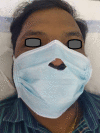Covid 19 Pandemic-Training of Healthcare Workers in Obtaining a Nasopharyngeal Swab: Our Experience
- PMID: 34540649
- PMCID: PMC8442653
- DOI: 10.1007/s12070-021-02849-6
Covid 19 Pandemic-Training of Healthcare Workers in Obtaining a Nasopharyngeal Swab: Our Experience
Abstract
To describe the training of healthcare workers (HCW) in nasopharyngeal swabbing during the COVID 19 pandemic.
Study design: Retrospective study.
Setting: Tertiary care teaching hospital.
Subjects and methods: One hundred and seventy eight health care workers were trained from May 2020 to January 2021. Three modules were designed to train the health care workers in the technique of obtaining a nasopharyngeal swab specimen.Training consisted of an instructional video on how to perform nasopharyngeal swabs and live demonstration followed by hands-on supervised training. The trainees included 30 doctors, 101 nurses, 31 respiratory therapists, 3 physiotherapists, 9 interns and 4 lab technicians. There were 39 male and 139 female trainees. After attending all 3 modules of training, they were confident and efficient in taking a non-traumatic nasopharyngeal swab. Good knowledge and adequate training is key to a good nasopharyngeal sampling for SARS CoV-2 testing.
Keywords: COVID 19 pandemic; Health care worker; Nasopharyngeal swab; SARS CoV-2.
© Association of Otolaryngologists of India 2021.
Conflict of interest statement
Conflict of interestThe authors have no conflict of interest to disclose in this work.
Figures
References
-
- World Health Organization (2020) Laboratory testing for 2019 novel coronavirus (2019-nCoV) in suspected human cases. Interim guidance. WHO/COVID-19/laboratory/2020.5. World Health Organization, Geneva, Switzerland. https://www.who.int/publications-detail/laboratory-testing-for-2019-nove....
-
- Mawaddah A, Gendeh HS, Lum SG, Marina MB. Upper respiratory tract sampling in COVID-19. Malays J Pathol. 2020;42:23–35. - PubMed
LinkOut - more resources
Full Text Sources
Miscellaneous




